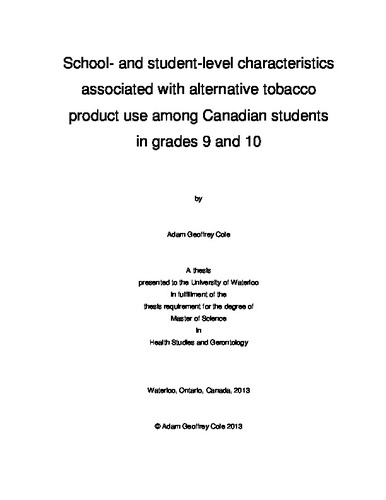| dc.description.abstract | Objective: This study compared the prevalence of use of six alternative tobacco products [ATPs] among Canadian students in grades 9 and 10, identified between-school variability in the current use of each ATP, and identified the school- and student-level characteristics associated with the use of each ATP.
Methods: This cross-sectional study used nationally representative student data collected from 14,916 students in grades 9 and 10 from 134 secondary schools as part of the 2010-11 Youth Smoking Survey and data from the 2010-11 Enhanced Points of Interest data file. Multilevel regression analyses examined the association between school- and student-level characteristics and the use of each ATP.
Results: Among Canadian students in grades 9 and 10, 15.4% reported currently using a tobacco product. Cigarillos or little cigars were the most prevalent product (6.3%) and bidis were the least prevalence product (0.6%). School-level differences accounted for between 14.1% and 31.2% of the variability in use. Grades 9 and 10 students who attended schools with a high rate of senior students that smoked manufactured cigarettes were significantly more likely to currently use cigarillos or little cigars (AOR 1.79, 95%CI 1.21 to 2.65) and roll-your-own cigarettes (AOR 1.88, 95%CI 1.15 to 3.07). Grades 9 and 10 students who reported having ever used flavoured tobacco products were significantly more likely to currently use cigarillos or little cigars, cigars, roll-your-own cigarettes, smokeless tobacco, and a hookah (AOR range 1.87 to 18.40). Finally, grades 9 and 10 students who reported currently using alcohol (AOR range 1.99 to 3.06) or marijuana (AOR range 2.09 to 3.47) were significantly more likely to currently use cigarillos or little cigars, cigars, and a hookah.
Conclusions: Many students reported currently using one or more ATPs, and these data illustrate that there is a population of students who are not represented in current smoking prevalence estimates. The school environment continues to play an important role in tobacco control as the rate of tobacco use among senior students affects the use of ATPs by younger students. Future tobacco control strategies need to be inclusive of all tobacco products. | en |

